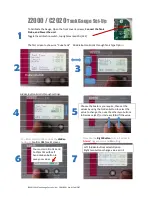
ENG-00178-20P-PPC-E10_User_Manual.docdoc
-7-
Rev 2.0 © 2014 EMAC, Inc.
The pinout for the J1 power connector is as follows:
Pin
Signal
1
+Vin (+12Vdc to 26Vdc)
2
Chassis GND
3
System GND
Before powering up the PPC-E10, jumper JB1
is in the “B” position
1.6
Ethernet
The PPC-E10 provides 10/100 Base-T full duplex Ethernet and uses a standard RJ-45 connector (JK2). It can be
connected straight to a hub, or another computer via a crossover Ethernet cable. The Ethernet MAC & PHY are
integrated into the SoM processor module. Activity and Link LEDs are integrated into the RJ45 connector.
1.7
Serial Ports
The PPC-E10 is equipped with four serial ports, one of which terminates to a male DB9 and the other three which
terminate to 10pin header connectors (see table 2, 3, & 4 below). Three 10-pin header to male DB9 connector
cables are provided, giving easy access to these ports. Baud Rate, stop bits, etc. are all programmable for each
port via software.
COM A is an RS232 compatible port with a full complement of handshaking lines (through the use of GPIO lines)
allowing it to communicate with modems and other devices requiring hardware flow control.
COM B is an RS232 port. This port offers no handshake lines.
COM C can be configured to RS232, RS422, and RS485 via 2 jumpers. To select RS232 set jumper JB6 to 232
(this is the default). For RS422 set jumper JB6 to 4xx and jumper JB5 to 485. To select RS485, set jumper JB6 to
4xx and jumper JB5 to 422.
When using COM C in the RS422/485 mode, a terminating resistor (~120 Ohm) is recommended on the two far
ends of the network.
COM D is an RS232 port. This port offers no handshake lines.
Table 1 (COM A Pinout)
#
Pin Description for DB9
Connector
1
DCD
2
RxD
3
TxD
4
DTR
5
GND
6
DSR
7
RTS
8
CTS
9
RI
10
Shield







































